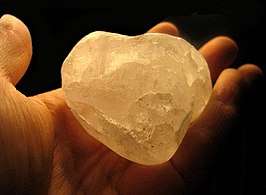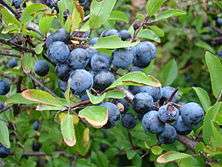Astringent
An astringent (sometimes called adstringent) is a chemical that shrinks or constricts body tissues. The word derives from the Latin adstringere, which means "to bind fast". Calamine lotion, witch hazel, and yerba mansa, a Californian plant, are astringents.[1]


Astringency, the dry, puckering mouthfeel caused by the tannins in unripe fruits, lets the fruit mature by deterring eating. Ripe fruits and fruit parts including blackthorn (sloe berries), Aronia chokeberry, chokecherry, bird cherry, rhubarb, quince and persimmon fruits, and banana skins are very astringent; citrus fruits, like lemons, are somewhat astringent. Tannins, being a kind of polyphenol, bind salivary proteins and make them precipitate and aggregate,[2] producing a rough, "sandpapery", or dry sensation in the mouth. The tannins in some teas and red grape wines like Cabernet Sauvignon and Merlot produce mild astringency.
Uses
In medicine, astringents cause constriction or contraction of mucous membranes and exposed tissues and are often used internally to reduce discharge of blood serum and mucous secretions.[3] This can happen with a sore throat, hemorrhages, diarrhea, and peptic ulcers. Externally applied astringents, which cause mild coagulation of skin proteins, dry, harden, and protect the skin.[4] People with acne are often advised to use astringents if they have oily skin.[5] Mild astringents relieve such minor skin irritations as those resulting from superficial cuts; allergies; insect bites;[4] anal hemorrhoids;[6] and fungal infections such as athlete's foot.[7]
Some common astringents are alum, acacia, sage,[8] yarrow,[9] witch hazel, bayberry, distilled vinegar, very cold water, and rubbing alcohol. Astringent preparations include silver nitrate, potassium permanganate, zinc oxide, zinc sulfate, Burow's solution, tincture of benzoin, and such vegetable substances as tannic and gallic acids. Balaustines are the red rose-like flowers of the pomegranate, which are very bitter to the taste. In medicine, their dried form has been used as an astringent.[10] Some metal salts and acids have also been used as astringents.[11] Redness-reducing eye drops contain an astringent. Use of Goulard's Extract has been discontinued, because of lead poisoning.
References
- Anemopsis californica from University of California, Irvine
- Fennema, Food Chemistry, 4th ed., p. 656.
- Brodin, Michael (1998). The Over-The-Counter Drug Book. Simon and Schuster. p. 382. ISBN 978-0-671-01380-6. Retrieved 4 June 2014.
- Peter A. Ciullo (31 December 1996). Industrial Minerals and Their Uses: A Handbook and Formulary. William Andrew. p. 407. ISBN 978-0-8155-1808-2. Retrieved 4 June 2014.
- Acne from http://www.brown.edu
- Acheson, Austin; Scholefield, John (2008-02-16). "Management of haemorrhoids". BMJ. 336 (7640): 380–383. doi:10.1136/bmj.39465.674745.80. PMC 2244760. PMID 18276714.
- Dockery, Gary L.; Crawford, Mary Elizabeth (1999). Color Atlas of Foot and Ankle Dermatology. Lippincott Williams & Wilkins. p. 171. ISBN 978-0-397-51519-6. Retrieved 4 June 2014.
- Dorland, W. A. Newman (1907). The American illustrated medical dictionary (4th ed.). Philadelphia and London: W.B. Saunders company. pp. 14, 39, 635. Retrieved 4 June 2014.
- Grieve, Maud (1 June 1971). A Modern Herbal: The Medicinal, Culinary, Cosmetic and Economic Properties, Cultivation and Folk-lore of Herbs, Grasses, Fungi, Shrubs, & Trees with All Their Modern Scientific Uses. Dover Publications. pp. 863–864. ISBN 978-0-486-22799-3. Retrieved 4 June 2014.
- History of Science: Cyclopædia, or, An universal dictionary of arts and sciences…
- Gregory, James (1833). Conspectus medicinae theoreticae: a view of the theory of medicine; in two parts: Part I. Containing physiology and pathology. Part II. Containing therapeutics (2nd ed.). London: Stirling & Kenneg. pp. 255–256. Retrieved 4 June 2014.
External links
